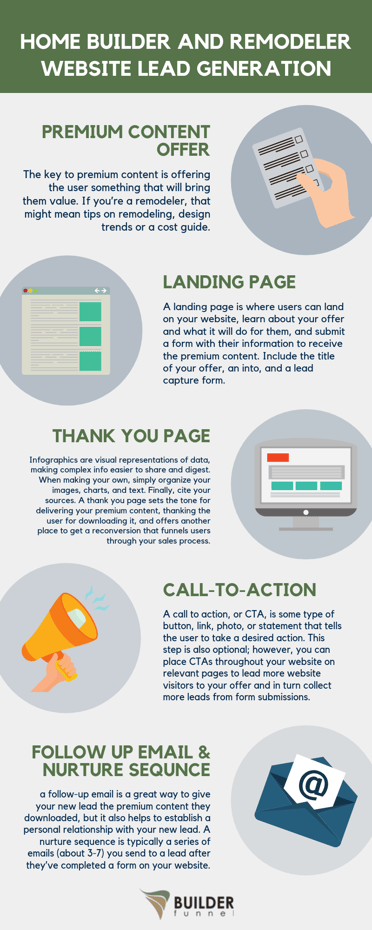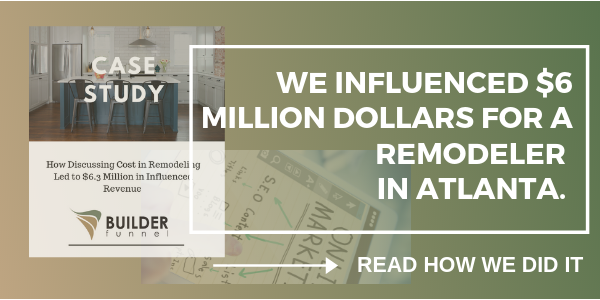
As a remodeler, you know how important having a full sales pipeline is for continuing business. If you don’t have leads at each stage of the sales funnel, you’re bound to have slow times with no projects to work on. But, what if you could use your website as a lead generation tool to collect more leads and nurture those leads through your sales funnel? The good news is, you can. In this post, we’ll explain how.
What Is a Lead Generation Website?
A lead generation website allows the website to collect information on the users that visit the site through contact forms. These forms typically collect information on the user that will help the business follow up and nurture the lead through their sales funnel. Examples of commonly used form fields include email, name, and phone number. If you’re a remodeler, you could even add form fields such as: "What room do you want to remodel?", "What’s your budget?", or other qualifying fields.
How to Build a Lead Generation Website
Building a lead generation website is simple. In order to have a lead generation website, you need to be able to collect information. The best way to collect a user’s information is with premium content (AKA “lead generation offers” or “gated content”). Premium content is material you create that users who visit your website would be interested in downloading. You offer the content if the user fills out the form on the page. Once the user has given their information, they receive the premium content offer and can download the content to refer back to at a later date.
At Builder Funnel, many of our remodeling clients use eBooks and checklists to share their content on the design process, the cost to remodel, a guide to kitchen remodeling, or other helpful content that users want to know more about. So what’s the best way to attract users, get them to fill out the form, and become a lead in your CRM? In the next section we explain our basic formula for creating leads with a lead generation offer.
Related: make sure your remodeling website has a content plan that caters to your ideal buyers.
Lead Generation Website Design For Remodelers
Through our extensive research and implementation of lead generation campaigns, we’ve found a simple formula to help your business generate more leads right from your website pages. To be successful, you’ll need a few components including a premium content offer, call to action (CTA), landing page, thank you page, follow-up email, and nurture sequence.
Premium Content Offer
We talked a little bit about what a premium content offer is in the last section, but why is this piece so critical to obtaining leads online? Why can’t you slap a form on a page and wait for the leads to come rolling in? Well, most people hold their privacy in high regard and don’t give their personal information out to anyone on the internet. So why should they give you their valuable information? What can you offer them that is worth their name and email address (and whatever else you ask of them)?
We talked about some ideas for premium content in the last section, but the key to premium content is offering the user something that will bring them value. If you’re a remodeler, that might mean tips on remodeling, design trends, or — like mentioned earlier — a cost guide. If you know what consumers are asking, you can answer their questions in a downloadable premium content offer that gives them the information they are looking for, which will also build trust between your business and the user.
Create an easy to digest and visually appealing content offer. Utilize free graphic design tools like Canva.com to make sure your premium content is premium and brings delight when a user downloads the item. Lastly, make sure you are true to what you’re offering. If you tell consumers you’re giving them a kitchen cost guide, be sure your content offer is actually helpful and explains the ins and outs of kitchen costs. Ranges and examples go a long way when talking about the cost because there are so many different variables that go into the cost of remodeling.
Landing Page
Once you have an ebook as a PDF, you can create a landing page where users can land on your website, learn about your offer and what it will do for them, and submit a form with their information to receive the premium content. As a best practice, include the title of your offer; an intro on what your offer is and how it will help the consumer accomplish their goals, and a lead capture form that will allow you to collect the user's information. You could also add a video, photo, or graphic to further entice users to fill out the form and download your content
Thank You Page
A thank you page is optional. However, it sets a nice tone for delivering your premium content, thanking the user for downloading it, and offers another place to get a re-conversion on another premium content offer that funnels users through your sales process. A thank you page is a website page that the user will be transferred to after completing the form on your landing page. This is a common way to deliver the premium content to the user right away. However, you can also provide an inline thank you message (a message that populates the area where the form was after the form has been submitted) after the user submits the form with a link to the content, or send them a follow-up email to their email address with the premium content offer.
Call-to-Action
A call to action, or CTA, is some type of button, link, photo, or statement that tells the user to take a desired action. This step is also optional; however, you can place CTAs throughout your website on relevant pages to lead more website visitors to your offer and in turn collect more leads from form submissions.
Follow-up Email
Another optional but highly effective way to nurture your customers is through a follow-up email. As mentioned in the thank you page section, a follow-up email is a great way to give your new lead the premium content they downloaded, but it also helps to establish a personal relationship with your new lead. You can address the person by name (because they just filled out your form), offer them the download and tell them if they have any questions about the information, they can reach out to your business at no obligation.
Nurture Sequence
Similar to a follow-up email, a nurture sequence is a great way to encourage your leads through your sales funnel. A nurture sequence is typically a series of emails (about 3-7) you send to a lead after they’ve completed a form on your website. The first in the sequence is usually a follow-up email that gets sent immediately after they download a premium content offer. Then you continue to offer free content and knowledge to help your lead in their remodeling journey. Typically nurture emails are sent about a week apart and gradually move from top of funnel content to the middle of funnel content, to the bottom of the funnel content. Marketing automation tools are especially useful if you’re looking to use nurture sequences. You can set them up, and then they run automatically every time.
Overall, the main objective is to build up a massive subscriber base of interested buyers and potential clients. Not all of them will be ready to start a project right now. That's OK. The long-term goal is to build relationships with these subscribers by adding value, educating them and helping them through their research process. Once they are ready to start their project, you'll be on the top of their mind.




